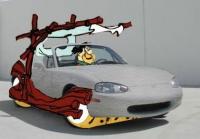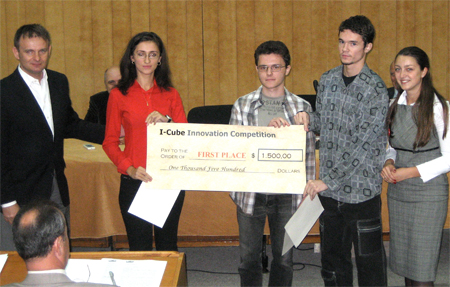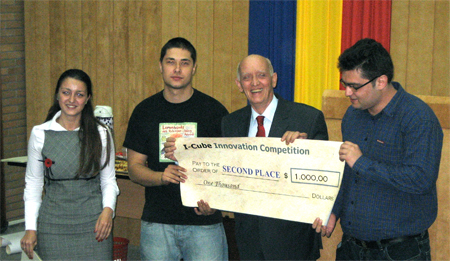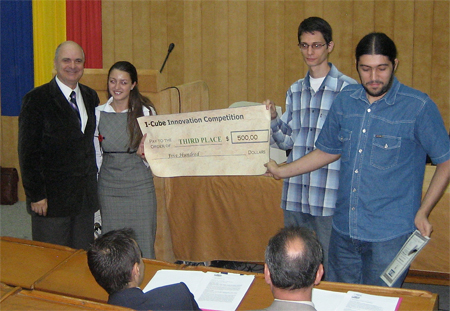I-Cube Innovation Competition 2007 Romania – Winners
I-Cube Innovation Competition see www.icube.ro
First Nanopros $1500 AWARD
Second Techs Team $1000 AWARD
Third Eye Vision Team $500 AWARD
NOTE: One person from each team will visit the US for one week in February 2008 to meet technologists, students, and investors
NANOPROS TEAM
Polytechnic University of Bucharest
Maria-Alexandra Paun, (Team Leader) – Faculty of Engineering in Foreign Languages
Andrei-Alexandru Trandafir – Faculty of Automatic Control and Computer Science
Viorel-Puiu – Faculty of Automatic Control and Computer Science
Innovation (nanotechnology):
The study of polymer transport through nanopores of biological membranes has been a central research subject in the last years. The physics behind this phenomenon has not been fully comprehended and applications like polymer (DNA, RNA etc.) translocation through narrow pores are challenging, even for renowned scientists.
Hence computer simulations (in both 2-D and 3-D) are a valuable tool for further research. Ultimately, we need to observe the connection between the number of monomers in the given polymer, the intensity of an external guiding electrical field and the required time for the monomer transportation through membrane pores. To this, the simulations give a better insight to the statistical processes occuring at these cellular levels.
This project could have a major impact on present-day medicine and pharmaceutical industry, since these techniques may be used to infiltrate and annihilate dangerous viruses or bacteria for which there is currently little or no cure.
We wish to both develop a software simulator for the above mentioned process, using 3-D computer graphics, and also to further investigate its characteristics and consequences.
Laurentiu Bucur (Team Leader) – Computer Science Faculty Polytechnic University of Bucharest
Alexandru Petrescu – Department of Physics (Princeton University)
Virgil Chitu – Bucharest Academy of Economic Studies
Innovation (algorithm):
“We propose an adaptive/predictive traffic routing service. Current “shortest-path” algorithms used in GIS solutions lack a dynamic model of traffic congestion and rely solely upon topology. Our approach is based on Bayesian networks for probabilistic modelling of road traffic and optimal route calculation in a transport graph. Supported by a GIS platform, our Adaptive Traffic Control solution is offered to the end-user as a subscription-based service, accessible through a Web site and an XML data service. Optional client software can be installed on any Internet-enabled mobile device with access to the XML data service for updates on statistically busy areas during the same recorded time period as the moment of access. Based on the location of their mobile device, users receive historically recorded congested traffic area warnings (in no planned route situations) and expected clearing times, as well as optimal routes in case of planned route queries sent to the ATCS. Our algorithms will rely on statistical traffic data gathered by our team during different times of day and weather conditions throughout the year on virtually all roads in the city; thus, queries will have the current time as input, besides the points of departure and arrival. We plan to start with a pilot area in the Capital, and when successful, expand to the rest of the country.”
EYE VISION TEAM
Polytechnic University of Bucharest
Faculty of Automatic Control and Computer Science
Stefan Dragan (Team Leader) – Faculty of Automatic Control and Computer Science
Marian Banica – Faculty of Automatic Control and Computer Science
Razvan Tatatoriu – Faculty of Automatic Control and Computer Science
Innovation (patterning technology):
“Iriscope is a system with a hardware component – which is in fact the iriscope, and a software part – which represents the “engine” of our project. An iriscope can replace the human interpretation of illnesses which can be discovered by looking at a “map” of an iris, in fact a 3D photo or video. With an iriscope you can take photos (or videos) from an eye and to interpret them using special maps (in according to iridiology science) for a general view of the hunam body’s condition This can expose illnesses which the pacient may be suffering.”






